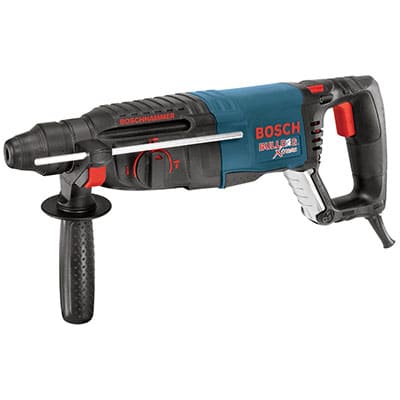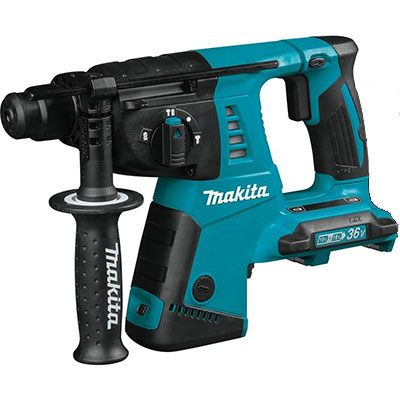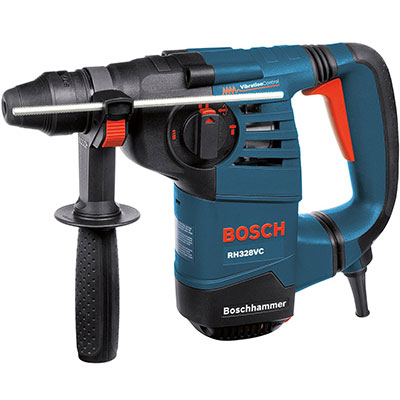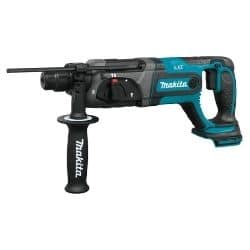Best Rotary Hammer Drill — Buyers Guide, Top Picks, and Comparison
Best Rotary Hammer Drill Categories

Electric Corded Hammer Rotary Drill Tool
Providing the maximum level of brawn in the entire drilling category — electric rotary hammer drills are the masters of dense material boring and masonry demolition. Featuring SDS+ compatible chucks, these units are as suited to the hardcore DIYer as the trade pro. With high impact rates, a variety of drilling and hammer action settings, and twin handles — these high amperage machines are crucial for home renovation, construction, and tearing down concretes.

Cordless SDS Rotary Hammer Drill
Sufficiently grunty to power through dense masonry and concrete, yet offering mains-free operation — cordless rotary hammer drills are the pinnacle of portable, high-level, on-site demolition tools. Boasting high bpm impact rates, twin or triple drilling action, and a vibration-busting build — these drilling behemoths are as suited to the extreme DIYer as the trade-pro. Arriving as either tool-only or a complete set — there’s an ideal unit for the cordless expert or battery-powered newbie.
Our Rotary Hammer Drill Top Picks
| IMAGE | PRODUCT | DETAILS | ||
|---|---|---|---|---|
|
Best Electric Rotary Corded Hammer Drill 
|
Best Electric Rotary Corded Hammer Drill
|
Bosch RH328VC
|
Features
|
Check Price at Amazon Bosch RH328VC Review Bosch RH328VC Review |
|
Best Cordless Rotary Hammer Drill 
|
Best Cordless Rotary Hammer Drill
|
Makita XRH04Z
|
Features
|
Check Price at Amazon Makita XRH04Z Review Makita XRH04Z Review |
Finding the Best Rotary Hammer Drill – Buyer’s Guide
Brawny, tough, and robust — rotary hammer drill machines are the monsters of the entire electric drilling category. Suitable for the daring DIYer and experienced trade contractor, these tools effortlessly drive and chisel the densest of target materials.
Available in both corded and cordless formats, these behemoths of boring are vital for construction and renovation projects — being able to tackle brickwork, concrete, cement, masonry, and bonded hardcore.
What Is a SDS Hammer Drill Rotary Machine?
In short, they’re the mothers of destruction.
Forget about precise and delicate boring into timbers — leave that to the ladies and interior designers. These Goliaths of grunt are built for fearless tool wielders who want to make light work of dense material drilling and demolition.
Although individual characteristics can vary from model to model — they all share the same features of:
Hammer Action
While many SDS rotary hammer drills will offer a standard rotational setting for straightforward hole boring — it’s their pummeling action that sets them apart from traditional drills.
Literally pounding away at your target material, they can drive and chip concretes and masonry — a feat unachievable with a standard machine.
Brawn Over Speed
Read any rotary hammer reviews, and you’ll struggle to find one that describes a machine that knocks out more than 1500 rpm. This is in contrast to standard corded drills that consistently provide a speed much greater than this.
That’s because rapidity is sacrificed for pure brawn. By gearing the motor down to provide grunt and not velocity, they’re ideally suited to pounding into dense concretes — not speedily driving screws into timber.
SDS Chuck
So, exactly what is an SDS drill? An SDS drill (Slotted Drive System or Shaft) is capable of accommodating SDS bits.
These unique bit shafts feature molded indentations that allow you to push the SDS head into a spring-loaded chuck — without the need for a key or manual tightening. Permitting the bit to slide forward and backward during rotary hammer drilling, it prevents damage to the drilling or chiseling head and enables a more accurate address of the target material.
If the machine doesn’t feature SDS compatibility — it’s not a true rotary drill.
Dual Handed Operation
Due to the immense forces delivered by the best roto hammer drills — two-handed operation is required to tame these beasts. Hence, all SDS rotary units — whether corded or cordless — will incorporate a front and rear-mounted grip handle.
Piston Drive
The ‘rotary’ element of these mighty units refers to the rotational drive of the twin pistons that power the hammer. For more detailed info on their working action, check out my ‘How Does a Rotary Hammer Drill Work?’ section below.
How Does a Rotary Hammer Drill Work
Here’s how it works:
As you squeeze the drill trigger, a variable resistor allows electricity to flow to the motor and rotate an internal crank — which repeatedly moves the first piston, the drive piston, backward and forward.
The motion of the drive piston pushes forward a column of air, which in turn exerts a force on the flying piston — creating the hammer action through an attached drill bit. As it functions by using compressed air, rotary drills are often referred to as electro-pneumatic drills.
I know what you’re wondering — why bother with the air and a secondary piston? The drive piston is already moving back and forth, so surely it would be more cost-efficient and simple to attach this directly to the drill bit?
It would, but you would lose the ability for immense brawn.
The compressed air not only drives the flying piston, but also provides an internal ‘cushion.’ This reduces the internal stress on the components, which would otherwise buckle and disintegrate as the bit pummels into dense concrete.
Uses for a Rotary SDS Hammer Drill
If you’re planning on putting up shelving, building cabinets, or erecting a shed — buddy, you’re in the wrong place. Instead, check out the best cordless hand drills. Equally, if your projects include working in car engines, operating in confined spaces, or close-quarter work — take a look at our right-angled drill top picks.
However, if you’re going to put on your big-boy pants and attack thick concretes and stubborn masonry — you need a cordless or electric rotary hammer drill. While not an exhaustive list, these juggernaut rotary jackhammer machines are ideal for:
Safe Use and Precautions for Rotary SDS Max Hammer Drill
Naturally, in any DIY or trade projects, you have to ensure that you and others are sufficiently protected. However, when wielding these weapons of mass demolition, these hazard avoiding measures are even more vital.
Hence always ensure that you:
- Don’t attempt any demolition work without checking for supporting walls.
- Border the area with tape or cones to prevent others from entering your operating area.
- Never operate your mighty tool while drunk or intoxicated.
- Always wear a protective mask, gloves, and eyewear.
- Check for hidden pipes or electrical wiring.
- Switch the tool off at the mains, or disconnect the battery, when not in use.
- Always use two hands to manipulate the tool.
- Ensure you use an SDS-rated bit.
Furthermore, as you’re addressing masonry, it’s crucial you understand the risks of drilling and demolition dust.
Bonded hardcore, castings, brick, concrete, and cement all contain silica in crystalline form. When you hack, bore, drill, and chip these mediums, they will release airborne silica particles — which, if inhaled, are seriously detrimental to your health.
Studies demonstrate that using a mechanical tool to bore into these dense materials can elevate airborne silica concentration to over 280 times the NIOSH’s (National Institute for Occupational Safety and Health) safe exposure limits.
While you may consider it ‘just dust,’ inhaling silica particles can result in:
- Chronic obstructive pulmonary disease.
- Cancer.
- Silicosis.
- Asthma.
Therefore, in addition to standard practice drilling safeguarding, it’s equally important to shield yourself from these masonry-bound contaminants by:
- Wearing a contractor-grade respiratory mask.
- Always drill or demolish in a well-ventilated area.
- Elevating air throughflow with an electric fan when inside.
- Taking frequent breaks.
- Working outside wherever possible.
- Frequently cleaning your operating area
- Using water to damp down dust on floors and surfaces to reduce airborne particles.
Rotary Hammer Drill Corded Machines
Undoubtedly, the most powerful of all rotary units.
Typically driven by a 7.0 amp motor or greater, corded SDS drill machines deliver impact rates in excess of 4000 bpm — although as already mentioned in this rotary hammer review, this is at the cost of drilling speed.
Often, the greater the amperage, the more brawn delivered by the tool — although brushed internal motors and step-down gearing can skew this somewhat. Hence, always check the manufacturer’s specs on rpm and bpm.
Apart from delivering a slightly higher power output than their cordless siblings, the key difference is that corded rotary models require connection to a mains outlet. While permitting consistent driving or hammering output with no loss of grunt — a cord can be an additional annoyance or safety hazard, and require you to work in locations with a power outlet (or generator).
The majority of rotary electric drills arrive with an eight-food lead as standard, which for most applications will be insufficient — meaning an extension cable is essential. Due to the high energy demands of these Herculean units, always ensure that your extension is suitably rated to the amperage of your particular model.
Pros of Hammer Rotary Corded Drills
- Most powerful hammer rotary SDS drills.
- No loss of power with extended use.
- Operational straight-outta-the-box — no additional battery or charger purchase.
- Lighter than cordless models as there’s no battery pack.
- Easier on the pocket than their cordless cousins.
Cons of Corded Hammer Rotary SDS Drills
- Cables can be a hazard.
- Awkward for high-level work.
- Require access to an external power source.
Cordless SDS Drill Rotary Hammer Machines
Without the hassle of mains tethering, cordless rotary units offer the greatest operational freedom in the SDS hammer drilling arena.
Driven by lithium-ion cells, typically 18-volts or above, these versatile tools ditch the handcuffs of cords and allow you to operate away from power outlets. This is why the majority of cordless rotary hammer drill reviews explain that they’re ideal portable tools for awkward site or high-level work.
Admittedly, they lag a little behind their corded counterparts in terms of power — but recent improvements in cordless technology have reduced this differential. The main concern is that for extended-period projects, especially those with high energy requirements such as demolition, the battery can rapidly deplete. Meaning that you either accept the hassle of long downtimes or require a ready supply of backup cells.
That said, most high-end battery-powered SDS machines feature brushless motors. More efficient than the brushed format — as energy isn’t wasted on heat and friction — this leads to impressive running times from a single cell, typically up to 45 minutes.
Just a quick word of caution.
When selecting a cordless SDS drill, check whether it’s supplied as tool-only, or complete with a battery and charger. As the majority of these machines target experienced DIYers or trade users — manufacturers often assume they will already own these crucial components for other cordless tools.
Pros of Cordless Hammer Rotary SDS Drills
- No requirement for power outlets.
- Ideal for high-level ladder or scaffold work.
- No cord tripping hazards.
- Efficient motors.
- Long-running times.
Cons of Right Angle Cordless Drills
- Harder on the pocket than corded units.
- Cordless SDS hammer drill reviews criticize their weight.
- Restricted by battery charge time.
- Often supplied without a cell and charger.
Considerations When Purchasing the Best Rotary Hammer Drill for Concrete, Brickwork, and Masonry
Both the mains-powered and the cordless rotary drill categories have their own particular features, quirks, and characteristics that you need to consider when picking your ultimate tool.
For these specific formats, I suggest you check out my two detailed guides on corded hammer rotary drills and battery-powered SDS machines. However, for a broad outline of both formats, here are the key factors you should deliberate upon before making a purchase.
Format
As explained above in this rotary hammer drill review — this powerful tool is available in two formats, corded and cordless.
For the optimum in power, brawn, and new-from-box operation, opt for a mains-driven machine. If you demand portability, freedom, and high-level accessibility, go for a battery-powered unit.
Number of Drilling Modes
As a minimum, all rotary hammer tools offer at least two drill settings — rotation, and hammer with rotation.
Rotation is the familiar, hole-driving operation of a standard drill — allowing you to bore into softer materials. Rotation plus hammer, as indicated by the title, adds a pummeling action to the turning feature, making it effortlessly plow through dense concretes and brickwork.
However, most high-end machines add a third operation mode — hammer (sometimes called chisel) only. This feature, as exemplified by the Tacklife TRH02A, allows the SDS rotary tool to complete pure smashing and demolition work — hammering away with no drill bit rotation. Hence, if your projects involve a significant volume of chipping work — it’s worth opting for a unit with this feature.
Impact Intensity
The impact intensity, typically expressed as bpm (blows per minute) in heavy duty rotary hammer drill reviews, explains how frequently the bit or chisel head pounds your target material.
Generally speaking, the more impacts, the faster and more effective the demolishing or drilling action in dense concrete and masonry. Ideally, look for a machine that provides in excess of 4000 bpm. The behemoth Bosch 11255VSR knocks out an eye-watering 5800 bpm.
However, it’s also prudent to check out the power emitted by these blows, measured in ft-lbs (foot-pounds). While high-volume impacts are a bonus, it’s of little use if they’re weak and pathetic.
Vibration Reduction System
When you’re using a monster machine to drive and demolish the densest of materials — it places stress on your arms, hands, wrist, and fingers.
Consistent pummelling — particularly over long time periods — will induce pain, aches, and elevate the onset of fatigue. In the worst-case scenarios, it can lead to permanent physical damage to the operator’s vascular and nervous systems.
Therefore, it’s wise to look for a unit, like the Makita XRH05Z, that incorporates a vibration-reduction system. Typified by in-build shock-absorbers and padded handles, these shielding units ensure more pleasurable drilling operation, extend working stamina, and protect you from harm.
Speed Settings
While this SDS drill rotary hammer review has explained that pounding into concrete and masonry is intense — it’s important to maintain control.
Excessive speed and power may cause damage to your base material — which is why some rotary tools, like the Bosch RH328VC, incorporate user-selectable rapidity settings.
In effect, they act as limiters, providing an upper ceiling to the unit’s output grunt — irrespective of how tightly you apply pressure to the tool’s trigger. This can be particularly useful in area-specific demolition projects, where you’re trying to chisel away a small section — not an entire wall or building.
Auxiliary Handle
Due to the intense force demanded by drilling or chipping masonry, all rotary units include two handles — the standard rear pistol grip and an auxiliary front-mounted handle.
However, I suggest checking whether the secondary foremost grip is rotatable. A number of hammer SDS machines — for example, the DeWalt D25263K — allow you to turn this handle through 360 degrees. This permits you to adjust your hold on the machine to suit the requirements of your current project.
Accessories
Examining exactly what elements are supplied with your rotary hammer tool can prevent disappointment when unboxing, and deliver a cost-effective tool.
While not exhaustive, check whether your chosen machine includes:
- Battery and charger (for cordless machines).
- Drill bits.
- Depth gauge.
- Tool wrench.
- Carry case.
- Lubricant.
- Replacement or interchangeable chucks.
- Cord protector (for mains units).
- Comprehensive warranty.
Conclusion
These hulks of hammering effortlessly drive into the most stubborn of target materials, including masonry, concrete, brickwork, and bonded hardcore. Not just allowing for extreme boring action, these beasts of brawn can also act as powerful chiseling and demolition tools.
With eye-watering impact rates, twin handles, and vibration reduction systems — these machines are the ideal units for construction, property renovation, and outdoor fabrication.
Always check that your chosen unit has the brawn suitable for your planned projects, a battery-powered or mains-driven motor concomitant to your operational needs, and the accessories you require to utilize the tool from day one.
Sure, these titans of tools are not for the faint-hearted — being massive overkill for the casual home user. However, if you’re a fearless and aspirational DIYer, or a trade pro, nothing can match the brutish punch of a rotary hammer drill.
Rotary SDS Hammer Drill FAQs
Q: What Is the Best Rotary Drill?
If you’re looking for a mains-driven machine, I’d suggest the Bosch RH328VC, with its mighty 2.4 ft-lbs of impact, is the ultimate tool. Alternatively, if you’re seeking a cordless tool, I’d recommend checking out the contractor-grade Makita XRH04Z.
Q: Who Makes the Best Hammer Rotary SDS Drills?
Based on my personal experience, customer reviews, and the opinions of trade contractors — the ultimate hammer rotary drills are manufactured by DeWalt, Makita, and Bosch.
Q: What Sized Chuck for Rotary Drills?
True, rotary hammer drill machines will feature an SDS+ compatible chuck — crucial to permit the pounding action.
Q: Where Can I Get a Right Angle Rotary Hammer?
You can’t. Right angle drills, designed for confined space work, work on a clutch drive system. Conversely, rotary hammers function with a dual-piston construction — the two formats are not compatible.
Q: Will an SDS Rotary Drill Timber?
It will, but it will destroy the wood.
Rotary hammer drills are too powerful for timber applications, being instead designed for tackling masonry and concrete. If you’re seeking a machine for wood projects, check out these machines.
Q: Can I Drive Screws With an SDS Rotary Hammer Drill?
No. Rotary drills are specifically for boring and demolishing high-density materials, not screwdriving. If you’re looking for a driver, check out these tools.
